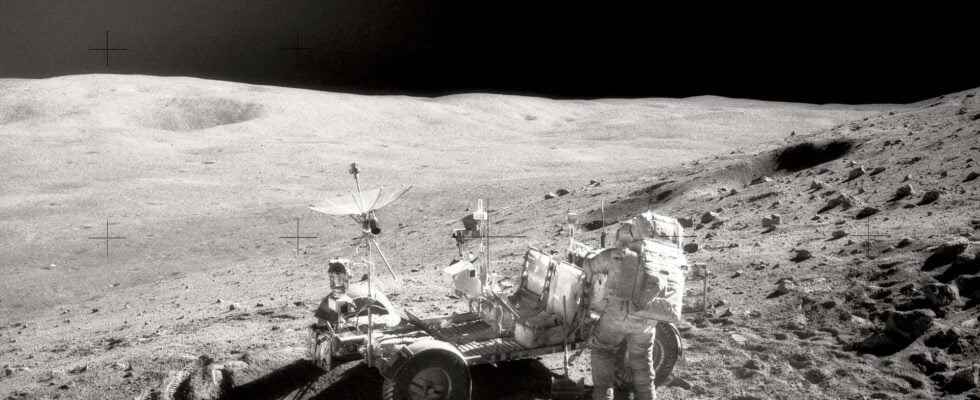Rocks from the Apollo missions have provided information about the history of the Moon and the formation of its crust and mantle. But more recent mineralogical data, notably from space probes, lead to modify the scenario of the genesis of the lunar crust by cooling of a global magmatic ocean more than 4 billion years ago.
The Apollo missions revolutionized our theories concerning the origin of the Moon by bringing back to Earth samples of lunar rocks whose mineralogical, chemical and isotopic compositions have delighted cosmogonists and planetologists.
From the analyzes of the rocks reported by the mission Apollo 11, the researchers noticed that the crust lunar seemed abnormally rich in minerals known on Earth under the name of plagioclases and which in this case largely constituted rocks called anorthosites. Plagioclases are a large family of silicate minerals, tectosilicates of the family of feldspars, which is found in basalts oceanic and granitoids of our Blue Planet in abundance, but not in the quantities of the lunar crust. Curiously, in it, minerals likeolivine and pyroxene are rare. On Earth, they are more abundant in its crust and olivine is known to be the mineral dominating peridotites, the rocks constituting the majority of the coat. Pyroxenes are common components of igneous rocks and metamorphic.
An ocean of global magma
Very quickly, the selenologists explained the data provided by the Apollo rock samples with the following model which will be consolidated by the giant impact thesis to explain the origin of the Moon, thesis also implied by lunar rocks.
At the very beginning of the formation of our satellite by accretion, this was done so quickly that theenergy gravitational potential released (not to mention the contribution of radioactive elements present in much greater quantities at that time) heated it much more quickly than it had time to cool down, so that a global ocean of magma – being able to reach a hundred kilometers to more than a thousand kilometers of depth.
On cooling, some minerals were formed first, having a point of merger lower than others and, according to their density, a chemical sorting was carried out under the effect of the lunar gravitation. A ferrous core has therefore formed surrounded by a mantle from a magmatic ocean in which olivine, pyroxene and the series of minerals they form have plunged into the depths while, lighter, the plagioclases of cooled anorthosites rose to the surface to float on the ocean and give the current lunar crust which solidified by cooling, there also like the mantle. It is estimated that the ocean existed from a few tens to a few hundred million years after the birth of the Moon but, like its exact depth, there are uncertainties according to the models and hypotheses considered, such as the exact composition of the material lunar initial.
A “mud” of magma and crystals in convection
A variant of this scenario has just been proposed in an article published in Geophysical Research Letters by two geoscience researchers, Chloé Michaut from the École Normale Supérieure in Lyon and Jerome A. Neufeld from the University of Cambridge.
They argue that since the Apollo missions, knowledge of the mineralogical composition of the Moon has been refined not only because it has been realized that certain meteorites found on Earth were of lunar origin and therefore extended the surface ofsampling of the Moon, but also thanks to the data provided by the lunar probes in orbit. In this regard, we can cite the contributions of the Indian missions Chandrayaan Where Clementine of the Nasa.
It has become clear that lunar anorthosites are more heterogeneous in their composition than initially thought, which is inconsistent with a common origin of these minerals through a single physico-chemical process.
The press release from the École Normale Supérieure in Lyon about the publication, highlighted today, therefore explains that the plagioclase crystals must have remained in suspension inside the Moon for a certain time and that the formation of the lunar crust would have started only when a critical crystal content was reached.
The magmatic ocean would have in fact remained in the state of a kind of mud with these crystals in a convective state, the weak gravity moon making the separation liquid-crystal difficult in such an ocean according to this statement. Cooling would have increased the number of plagioclase crystals but without them separating to form two distinct phases until a threshold was reached. But, once this is done, a stagnant layer would form in which different anorthosites would have formed over time for several hundred million years by extraction of an evolving lighter magmatic liquid from the ocean still convective.
This explanation accounts not only for the heterogeneity of the anorthosites in the crust, but also for the age variations associated with them.
The press release from the ENS finally specifies that: Serial magmatism was initially proposed by other authors as a possible mechanism for the formation of lunar anorthosites, but antagonistically to the idea of an ocean of lunar magma. This model of crystalline mud proposed by Chloé Michaut and Jerome A. Neufeld could finally reconcile this idea with that of a global lunar magma ocean. »
Interested in what you just read?
